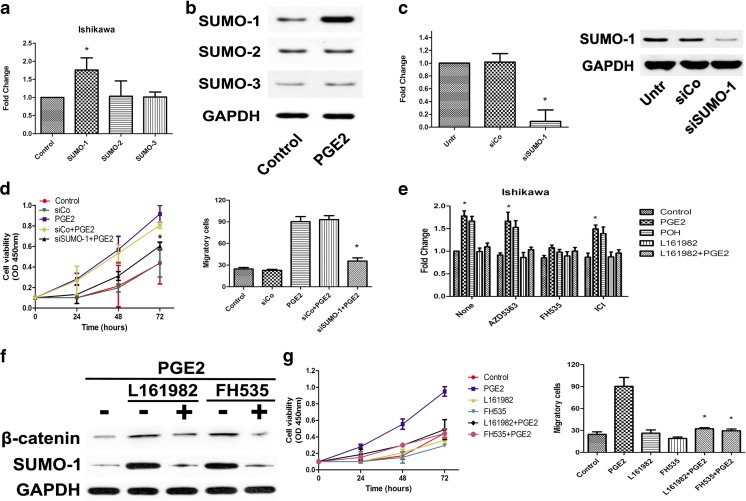Fig. 4.
PGE2 promotes endometrial cancer cell proliferation and invasion by stimulates SUMO-1 a RT-PCR analysis for three SUMO subtypes in Ishikawa cells after PGE2 stimulated. *p < 0.05, analyzed by one-way analysis of variance (ANOVA). b Western blot tests for three SUMO subtypes in Ishikawa cells after PGE2 stimulated. c RT-PCR analysis and western blot tests in Ishikawa cells after transfected with SUMO-1 siRNAs. *p < 0.05 versus control group, tested with unpaired Student’s t test. d CCK8 assays were conducted at each time point to quantify cell viability for Ishikawa cells after transfection of SUMO-1 siRNAs. *p < 0.05, analyzed by one-way analysis of variance (ANOVA). e Ishikawa cells were treated with AZD5363 (1 × 10–6 mol/L), FH535 (1.5 × 10–6 mol/L), and ICI (1 × 10−6 mol/L) for 24 h. Then stimulated with PGE2, POH, or L161982. RT-PCR analysis for SUMO-1 in Ishikawa cells. *p < 0.05, analyzed by one-way analysis of variance (ANOVA). f Ishikawa cells were treated with FH535 (1.5 × 10–6 mol/L) or L161982 (10 × 10–9 mol/L) for 24 h, then stimulated with or without PGE2. Western blot tests for β-catenin and SUMO-1 in Ishikawa cells. g CCK8 assays were conducted at each time point to quantify cell viability for Ishikawa cells treated with PGE2 (1 × 10–9 mol/L), FH535 (1.5 × 10–6 mol/L), or L161982 (10 × 10–9 mol/L). Transwell for Ishikawa cells treated with PGE2 (1 × 10–9 mol/L), FH535 (1.5 × 10–6 mol/L) or L161982 (10 × 10−9 mol/L). Figure shows the number of invasive cells for each group (averaged across five random images). *p < 0.05, analyzed by one-way analysis of variance (ANOVA)

